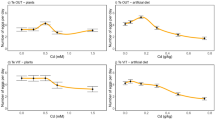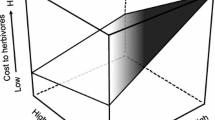Abstract
The leading hypothesis for the evolution of the metal hyperaccumulation trait in plants is as a defense against herbivores. A central piece of evidence expected for this hypothesis is that plants benefit from herbivores being deterred from eating high metal tissues. While many studies have investigated whether or not herbivores are deterred by high metal feeds, there has been no quantitative synthesis of these studies. We performed a Bayesian meta-analysis of 31 feeding choice trials from ten published studies, where invertebrates were offered diets of plant tissue from hyperaccumulating species with high and low metal concentrations. Results of individual trials ranged from distinct preference to distinct aversion for high metal diets. The overall mean effect was for herbivore aversion to high metal diets, whether we used fixed or random effects. However, random effect models were better supported than fixed effect models, indicating there was much real variation between trials. This variation could be attributed partly to each of herbivores, plants, studies, and metals, with herbivores being the greatest source of variation. On average, high metal diets deterred insects but not gastropods, which is supported by other research of metal tolerance and sequestration by gastropods. This suggests that the evolution of hyperaccumulation may have differing selective pressures depending upon the suite of herbivores the plants are naturally exposed to. Future studies should give greater consideration to the selection of herbivores and plants tested.


Similar content being viewed by others
Notes
Metal hyperaccumulating plants generally are considered to include those that hyperaccumulate metals, such as zinc or copper, and/or metalloids, such as selenium or boron. Throughout this paper, the term metal is used to include both metals and metalloids.
References
Baker, A. J. M., Mcgrath, S. P., Reeves, R. D., and Smith, J. A. C. 2000. Metal hyperaccumulator plants: a review of the ecology and physiology of a biological resource for phytoremediation of metal-polluted soils, pp. 85–107, in N. Terry, and G. Banuelos (eds.). Phytoremediation of Contaminated Soil and Water. Lewis, Boca Raton.
Behmer, S. T., Lloyd, C. M., Raubenheimer, D., Stewart-Clark, J., Knight, J., Leighton, R. S., Harper, F. A., and Smith, J. A. C. 2005. Metal hyperaccumulation in plants: mechanisms of defence against insect herbivores. Func. Ecol. 19:55–66.
Berger, B., and Dallinger, R. 1989. Accumulation of cadmium and copper by the terrestrial snail Arianta arbustorum L.: kinetics and budgets. Oecologia 79:60–65.
Boyd, R. S. 2007. The defense hypothesis of elemental hyperaccumulation: status, challenges and new directions. Plant Soil 293:153–176.
Boyd, R. S., and Martens, S. N. 1992. The raison d’être for metal hyperaccumulation by plants, pp. 279–289, in A. J. M. Baker, J. Proctor, and R. D. Reeves (eds.). The Vegetation of Ultramafic (Serpentine) Soils: Proceedings of the First International Conference on Serpentine Ecology. Intercept, Andover, UK.
Boyd, R. S., and Martens, S. N. 1999. Aphids are unaffected by the elemental defence of the nickel hyperaccumulator Streptanthus polygaloides (Brassicaceae). Chemoecology 9:1–7.
Boyd, R., Davis, M., Wall, M., and Balkwill, K. 2002. Nickel defends the South African hyperaccumulator Senecio coronatus (Asteraceae) against Helix aspersa (Mollusca: Pulmonidae). Chemoecology 12:91–97.
Bushman, B. J. 1994. Vote counting methods in meta-analysis, pp. 193–213, in H. M. Cooper, and L. V. Hedges (eds.). Handbook of Research Synthesis. Russell Sage Foundation, New York.
Clark, J. S. 2005. Why environmental scientists are becoming Bayesians. Ecol. Lett. 8:2–14.
Coughtrey, P. J., and Martin, M. H. 1976. The distribution of Pb, Zn, Cd and Cu within the pulmonate mollusk Helix aspersa Muller. Oecologia 23:315–322.
Coughtrey, P. J., and Martin, M. H. 1977. The uptake of lead, zinc, cadmium and copper by the pulmonate mollusc Helix aspersa Muller, and its relevance to the monitoring of heavy metal contamination of the environment. Oecologia 27:65–74.
Freeman, J. L., Quinn, C. F., Marcus, M. A., Fakra, S., and Pilon-Smits, E. A. H. 2006. Selenium-tolerant diamondback moth disarms hyperaccumulator plant defense. Curr. Biol. 16:2181–2192.
Freeman, J. L., Lindblom, S. D., Quinn, C. F., Fakra, S., Marcus, M. A., and Pilon-Smits, E. A. H. 2007. Selenium accumulation protects plants from herbivory by Orthoptera via toxicity and deterrence. New Phytol. 175:490–500.
Hanson, B., Garifullina, G. F., Lindblom, S. D., Wangeline, A., Ackley, A., Kramer, K., Norton, A. P., Lawrence, C. B., and Pilon-Smits, E. A. H. 2003. Selenium accumulation protects Brassica juncea from invertebrate herbivory and fungal infection. New Phytol. 159:461–469.
Hanson, B., Lindblom, S. D., Loeffler, M. L., and Pilon-Smits, E. A. H. 2004. Selenium protects plants from phloem-feeding aphids due to both deterrence and toxicity. New Phytol. 162:655–662.
Hedges, L. V., and Olkin, I. 1980. Vote-counting methods in research synthesis. Psychol. Bull. 88:359–369.
Howard, B., Mitchell, P. C. H., Ritchie, A., Simkiss, K., and Taylor, M. 1981. The composition of intracellular granules from the metal-accumulating cells of the common garden snail (Helix aspersa). Biochem. J. 194:507–511.
Huitson, S. B., and Macnair, M. R. 2003. Does zinc protect the zinc hyperaccumulator Arabidopsis halleri from herbivory by snails? New Phytol. 159:453–459.
Jhee, E., Dandridge, K., Christy, A., and Pollard, A. 1999. Selective herbivory on low-zinc phenotypes of the hyperaccumulator Thlaspi caerulescens (Brassicaceae). Chemoecology 9:93–95.
Jhee, E. M., Boyd, R. S., and Eubanks, M. D. 2005. Nickel hyperaccumulation as an elemental defense of Streptanthus polygaloides (Brassicaceae): influence of herbivore feeding mode. New Phytol. 168:331–344.
Link, W. A., Cam, E., Nichols, J. D., and Cooch, E. G. 2002. Of BUGS and birds: Markov chain Monte Carlo for hierarchical modeling in wildlife research. J. Wildlife Manage. 66:277–291.
Lunn, D. J., Thomas, A., Best, N., and Spiegelhalter, D. 2000. WinBUGS - A Bayesian modelling framework: Concepts, structure, and extensibility. Statist. Comput. 10:325–337.
Marigomez, I., Soto, M., Cajaraville, M. P., Angulo, E., and Giamberini, L. 2002. Cellular and subcellular distribution of metals in molluscs. Microsc. Res. Tech. 56:358–392.
Martens, S. N., and Boyd, R. S. 1994. The ecological significance of nickel hyperaccumulation: a plant chemical defense. Oecologia 98:379–384.
Martens, S. N., and Boyd, R. S. 2002. The defensive role of Ni hyperaccumulation by plants: a field experiment. Am. J. Bot. 89:998–1003.
McCarthy, M. A. 2007. Bayesian Methods for Ecology. p. 310. Cambridge University Press, Cambridge, UK.
McCarthy, M. A., and Masters, P. 2005. Profiting from prior information in Bayesian analyses of ecological data. J. Appl. Ecol. 42:1012–1019.
Moller, A. P., and Jennions, M. D. 2001. Testing and adjusting for publication bias. Trends Ecol. Evol. 16:580–586.
Noret, N., Meerts, P., Tolra, R., Poschenrieder, C., Barcelo, J., and Escarre, J. 2005. Palatability of Thlaspi caerulescens for snails: influence of zinc and glucosinolates. New Phytol. 165:763–772.
Pollard, A. J. 2000. Metal hyperaccumulation: a model system for coevolutionary studies. New Phytol. 146:179–181.
Pollard, A. J., and Baker, A. J. M. 1997. Deterrence of herbivory by zinc hyperaccumulation in Thlaspi caerulescens (Brassicaceae). New Phytol. 135:655–658.
Raudenbush, S. 1994. Random effects models, pp. 301–321, in H. Cooper, and L. V. Hedges (eds.). The Handbook of Research Synthesis. Russell Sage Foundation, New York.
Reeves, R. D., and Baker, A. J. M. 2000. Metal-accumulating plants, pp. 193–229, in I. Raskin, and B. D. Ensley (eds.). Phytoremediation of Toxic Metals: Using Plants to Clean up the Environment. Wiley, New York.
Spiegelhalter, D. J., Thomas, A., Best, N. G., and Gilks, W. R. 1995. BUGS: Bayesian Inference Using Gibbs Sampling, Version 0.50. MRC Biostatistics Unit, Cambridge.
Spiegelhalter, D. J., Best, N. G., Carlin, B. R., and Van Der Linde, A. 2002. Bayesian measures of model complexity and fit. J. Roy. Stat. Soc. B 64:583–616.
Wall, M. A., and Boyd, R. S. 2006. Melanotrichus boydi (Hemiptera: Miridae) is a specialist on the nickel hyperaccumulator Streptanthus polygaloides (Brassicaceae). Southwest. Nat. 51:481–489.
Whiting, S. N., Reeves, R. D., Richards, D., Johnson, M. S., Cooke, J. A., Malaisse, F., Paton, A., Smith, J. A. C., Angle, J. S., Chaney, R. L., and Others 2004. Research priorities for conservation of metallophyte biodiversity and their potential for restoration and site remediation. Restor. Ecol. 12:106–116.
Zuur, G., Garthwaite, P. H., and Fryer, R. J. 2002. Practical use of MCMC methods: lessons from a case study. Biometr. J. 44:433–455.
Acknowledgments
Thanks to Mick McCarthy for help with BUGS models.
Author information
Authors and Affiliations
Corresponding author
Rights and permissions
About this article
Cite this article
Vesk, P.A., Reichman, S.M. Hyperaccumulators and Herbivores—A Bayesian Meta-Analysis of Feeding Choice Trials. J Chem Ecol 35, 289–296 (2009). https://doi.org/10.1007/s10886-009-9607-7
Received:
Revised:
Accepted:
Published:
Issue Date:
DOI: https://doi.org/10.1007/s10886-009-9607-7




